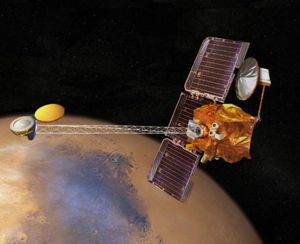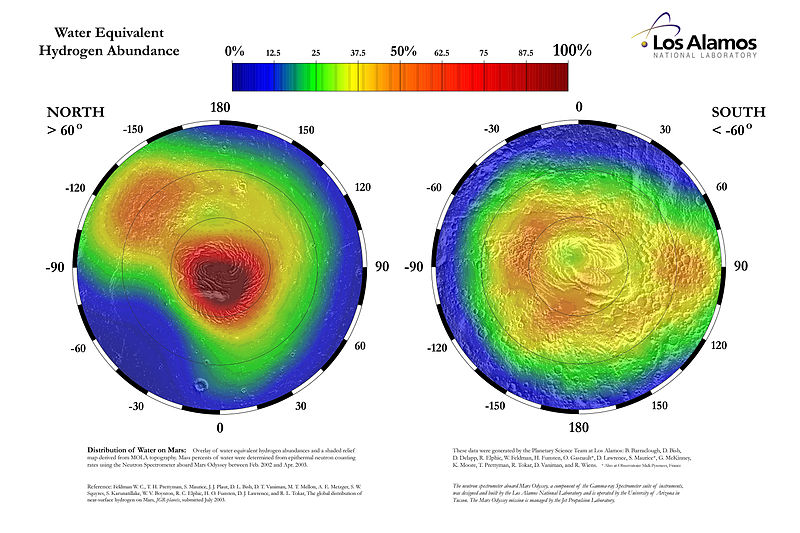Difference between revisions of "Mars Odyssey"
(→Results: added info and ref about amount of ice) |
|||
| Line 12: | Line 12: | ||
==Results== | ==Results== | ||
| − | The orbiter recorded and transmitted data about concentration and distribution of [[hydrogen]] and other chemicals of the Martian surface. Additionally, the [[radiation]] conditions were measured, covering ultra violet and gamma. | + | The orbiter recorded and transmitted data about concentration and distribution of [[hydrogen]] and other chemicals of the Martian surface. Additionally, the [[radiation]] conditions were measured, covering ultra violet and gamma. The amount of hydrogen detected is just about equal to the amount of water in the top meter of ground. Water contains 2 parts hydrogen and 1 part oxygen. On Mars, very little, if any, hydrogen comes from chemicals other than water. Detailed analysis of data from the gamma ray spectrometer showed that 20-50 % of the lower level (0.5-1 meter below the surface consists of water ice. Since ice is only half the density of rock, that means that one half of the bottom 50 cm is ice. In other words, one bucket of that material would contain one half bucket of ice.<ref>http://mars.jpl.gov/odyssey/newsroom/pressreleases/20020528a.html</ref> |
[[File:Water equivalent hydrogen abundance in the lower latitudes of Mars 01.jpg|600pxr|Map showing global abundance of water in the surface of Mars, as measured by Mars Odyssey | [[File:Water equivalent hydrogen abundance in the lower latitudes of Mars 01.jpg|600pxr|Map showing global abundance of water in the surface of Mars, as measured by Mars Odyssey | ||
Revision as of 13:41, 31 October 2018
| This article is a stub. You can help Marspedia by expanding it. |
- "2001 Mars Odyssey is part of NASA's Mars Exploration Program, a long-term effort of robotic exploration of the red planet. The opportunity to go to Mars comes around every 26 months, when the alignment of Earth and Mars in their orbits around the sun allows spacecraft to travel between the two planets with the least amount of energy. 2001 Mars Odyssey launched on April 7, 2001, and arrived at Mars on October 24, 2001, 0230 Universal Time (October 23, 7:30 pm PDT/ 10:30 EDT)." - Mission website.
After spacecraft's main engine fired to place Mars Odyssey into orbit around Mars. It took three months of aerobraking to reduce and circularize the orbit. Odyssey was able to save more than 200 kilograms (440 lb) of propellant by allowing atmospheric drag to slow the spacecraft in its final orbit instead of using fuel. The weight of fuel saved permitted the mission to use a Delta II 7925 launch vehicle, rather than a larger, more expensive rocket.[1]
Odyssey began its science mission on February 19, 2002. It's initial mission lasted until August 2004, but it was granted many mission extensions; consequently, it is still sending back data as of October 2018.[2]
Results
The orbiter recorded and transmitted data about concentration and distribution of hydrogen and other chemicals of the Martian surface. Additionally, the radiation conditions were measured, covering ultra violet and gamma. The amount of hydrogen detected is just about equal to the amount of water in the top meter of ground. Water contains 2 parts hydrogen and 1 part oxygen. On Mars, very little, if any, hydrogen comes from chemicals other than water. Detailed analysis of data from the gamma ray spectrometer showed that 20-50 % of the lower level (0.5-1 meter below the surface consists of water ice. Since ice is only half the density of rock, that means that one half of the bottom 50 cm is ice. In other words, one bucket of that material would contain one half bucket of ice.[3]
Map showing global abundance of water in upper meter of Mars, as measured by Mars Odyssey
Map showing abundance of water in the upper meter of Mars in the high latitudes, as measured by Mars Odyssey
How to see Mars Odyssey Pictures
You can find a map of all Mars Odyssey images at [[1]] http://global-data.mars.asu.edu/bin/themis.pl
Just click on the part of the map that you want to see Mars Odyssey pictures of.
Found substances
Open issues
What are the exact data?
References
- ↑ cite web|url=http://mars.jpl.nasa.gov/odyssey/newsroom/pressreleases/02jan11.html%7C title=Mars Odyssey: Newsroom| publisher=NASA Jet Propulsion Laboratory
- ↑ cite web|url=http://mars.nasa.gov/odyssey/mission/timeline/%7Ctitle=Mission Timeline - Mars Odyssey| publisher=NASA Jet Propulsion Laboratory
- ↑ http://mars.jpl.gov/odyssey/newsroom/pressreleases/20020528a.html
- ↑ New Scientist: Chloride salts on Mars may have preserved past life
- ↑ BBC: Mars is 'covered in table salt'









